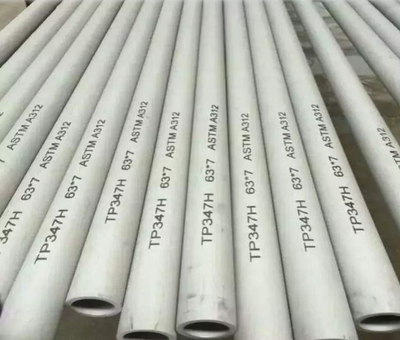Introduction to 347H Stainless Steel Pipe for High-Temperature Applications
347H stainless steel pipe is a high-carbon, niobium-stabilized austenitic stainless steel designed for superior performance in high-temperature and corrosive environments. With outstanding oxidation resistance, creep strength, and welding properties, it is widely applied in power generation, petrochemical, and aerospace industries. As a leading stainless steel pipe manufacturer, Ganyeah Group provides 347H stainless steel pipes that meet stringent international standards and ensure long-term stability under extreme conditions.

347H stainless steel pipes for power plant and chemical applications
1. Chemical Composition and Microstructure
Chemical Elements:
347H contains Carbon (0.04–0.10%), Chromium (17–19%), Nickel (9–13%), Niobium (8C–1.10%), Silicon (≤0.75%), and Manganese (≤2.00%). The addition of niobium (Nb) forms niobium carbides (NbC), preventing chromium carbide precipitation at grain boundaries and significantly improving intergranular corrosion resistance.
Microstructure:
After solution treatment at 1000–1100°C followed by rapid cooling, 347H exhibits a stable single-phase austenitic structure. Niobium enhances the microstructural stability, maintaining strength and toughness even during prolonged high-temperature service.
2. Key Performance Characteristics
High-Temperature Strength
- Tensile strength ≥ 515 MPa; yield strength ≥ 205 MPa (ASTM A213).
- At 600°C, allowable stress exceeds 100 MPa, outperforming 304H stainless steel.
Excellent Oxidation and Creep Resistance
- Stable oxidation resistance in air up to 850°C for non-pressurized applications.
- Creep rupture strength 15% higher than 321H, suitable for supercritical boiler systems.
Superior Corrosion Resistance
- Intergranular corrosion: Niobium stabilization ensures high resistance after welding.
- Chemical media: Performs well in nitric acid, acetic acid, and seawater; chloride pitting slightly higher than 316L but can be mitigated with surface treatment.
- Molten salt corrosion: Proven long-term stability in solar molten salt systems through field applications and lab testing.
Formability and Weldability
- Cold working: Requires intermediate annealing (850–900°C) to prevent work hardening.
- Welding: Use ER347 filler wire; TIG or PAW processes recommended.
- Heat treatment: Solution treatment at 980–1150°C, followed by water quenching.
3. Typical Industrial Applications
Power Generation
- Used in superheater and reheater tubes, and steam pipelines in power stations such as Huaneng Jinggangshan and Datang Yangcheng.
- Essential for molten salt storage tanks in solar thermal power plants, operating at 450–565°C.
Petrochemical Industry
- Utilized in ethylene cracking furnace tubes and hydrogenation reactors, where high-temperature corrosion resistance is critical.
Aerospace Applications
- Ideal for turbine compressor pipelines and exhaust systems operating below 850°C, offering excellent resistance to combustion gases.
4. Material Comparison Table
| Material | Key Advantages | Limitations | Typical Applications |
|---|---|---|---|
| 347H | High-temperature strength, excellent weldability | Higher cost | Power boilers, molten salt systems |
| 321H | Cost-effective, stable at moderate temperature | Ti burn-off during welding | General heat exchangers |
| 316H | Good chloride corrosion resistance | Insufficient high-temp strength | Chemical and marine use |
| 310S | Outstanding oxidation resistance (up to 1200°C) | Very high cost, low ductility | Furnace tubes, incinerators |
| 304H | Economical, general-purpose material | Limited high-temp resistance | Low-pressure piping systems |
5. Standards and Manufacturing Process
Standards:
- International: ASTM A213/SA213, EN 10216-5
- Chinese: GB/T 5310 (Grade: 07Cr18Ni11Nb)
Manufacturing Techniques:
- Hot Rolling: Billet heated to 1150–1200°C and rolled into seamless pipes, suitable for large-diameter heavy-wall tubes.
- Cold Drawing: Multiple-pass cold drawing for improved dimensional precision and surface finish.
- Welding: TIG or plasma welding for thin walls; submerged arc welding (SAW) for thick sections; 100% radiographic testing ensures quality.
6. Usage and Maintenance Recommendations
- Avoid prolonged use above 850°C in oxidizing atmospheres.
- Apply stress-relief annealing (650–700°C) after high-temperature exposure to prevent cracking.
- Perform surface treatments such as pickling, polishing, and passivation (HNO₃/HF solution) to enhance corrosion resistance.
347H stainless steel pipe combines high-temperature strength, excellent oxidation resistance, and superior weldability, making it indispensable in advanced energy and petrochemical systems. With expertise in material development and manufacturing, Ganyeah Group delivers reliable and high-performance stainless steel solutions tailored for power plants, chemical facilities, and solar energy systems. As global industries evolve toward higher efficiency and cleaner energy, the demand for 347H stainless steel pipes will continue to grow.
